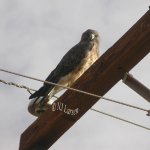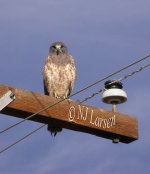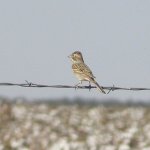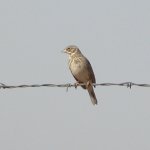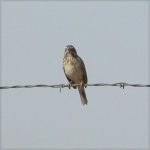Hi Everyone,
I’m a first time poster here, though I’ve been a lurker for a while. I take it that a JoeG from Oklahoma with a Black-capped Vireo avatar would be THE JoeG of Black-capped Vireo fame. I don't know if you remember me or not but we did some birding together some years back. Anyway, a big "Hi."
I just thought I would toss in my thoughts on these two mysteries. I agree that the first bird is a Swainson’s Hawk for the reasons Katy pointed out. The second bird is the one that seems more puzzling to me, mainly in that my initial snap judgment certainly did not pan out. Thoughts of Lark Bunting and Lark Sparrow popped into my head before settling on Brewer’s Sparrow. I think that the points favoring Brewer’s have been touched on here, with Joe being bothered by the pale spot on the rear of the auriculars. That seems unusually distinct to me too, but I think that that is okay. One more point favoring Brewer’s that I’m not sure I saw mentioned was the contrasting paler gray patch on the nape. This is typical of the small Spizella. Another thing that struck me initially, was how big headed the bird looked. But again, overall the plumage features seem to support Brewer’s. If one looks at these two images, I think that you can get a hint of a paler auricular spot:
http://www.rshantz.com/Animals/Birds/Sparrows/Brewers/20041127Sparrow01.htm
http://www.rshantz.com/Animals/Birds/Sparrows/Brewers/20041113Sparrow01.htm
Another sort of amusing comparison is to take this image of Lark Bunting and the mystery bird perched on barbed wire, and make a direct comparison of the size of the two birds relative to the thickness of the wire. To my eye, the mystery bird is considerably smaller than the Lark Bunting, a point that would support Brewer’s Sparrow. See:
http://tinyurl.com/8wg89
http://www.birdforum.net/attachment.php?attachmentid=33403
Also, I think that Sage Sparrow can be ruled out too, but I wanted to make a couple of comments about the juvenile photo that JanJ made mention of. See:
http://www.birdphotography.com/species/sags.html
Butterbredt Spring is in a high desert area in California where Sage Sparrow is a resident species. As is typical of many resident species in desert areas, breeding can be well underway before returning migrants have even reached their breeding areas. Butterbredt is a popular spot to visit for passerine migration in late May and early June, so my guess is that this photo was taken quite late in May. This is certainly late enough for juvenile Sage Sparrows to be out of the egg. There are a number of plumage features that suggest a juvenile too. First, the overall feathering (especially scapulars and underparts) has that flimsy juvenile feathering look. The wings, however, look rather fresh and in good condition, and the primary tips are each fringed with a nice pale border, which I would not expect on an adult at this date. The bird also looks streaked across the chest, but the angle is wrong for telling whether this is more extensive than on adults. Fortunately, other features support a juvenile too. There is no blue-gray cast to the head and upperparts as on adults, and the bird lacks the distinctive black lateral throat stripe of adult birds (compare with the adult in the image beneath). The bird also shows a broad, diffuse supercillium not found on adult birds. And finally, those who know him know the photographer to be an excellent birder who is unlikely to post mislabeled images.

Thanks for an interesting photo quiz!
Chris
Tucson, AZ





